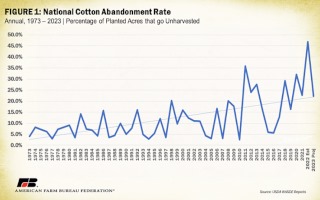Most plants can’t access this abundant nitrogen in the atmosphere, instead requiring nitrogen transformations to occur so that they can uptake nitrogen in the nitrate or ammonium forms with the water they are already accessing from the soil. Plant species in the legume family, however, have a unique ability to collaborate with a specific species of bacteria (Rhizobium) that can transform this atmospheric nitrogen into forms that plants can utilize. In return, microbes trade the plants for sugars that only the plants can create from atmospheric carbon dioxide and sunlight energy. This unique partnership makes nitrogen unique among the major plant nutrients in that nitrogen becomes a renewable resource, which is different than phosphorus, potassium, calcium, etc. that are all non-renewable. These non-nitrogen nutrients need to be mined or gathered somewhere else and moved to agricultural fields.
For years, the cheap price of nitrogen fertilizer combined with the ability to grow high yielding crops every year has minimized the use of legumes in crop rotations to bring nitrogen into the system. Recent increases in nitrogen fertilizer prices have inspired new interest in using legumes to supply some or all the nitrogen for cash crops. The challenge is that it takes time during the growing season to grow these legume crops to capture enough nitrogen to make them worthwhile. And, even though soybeans are legumes, they don’t leave much nitrogen behind for subsequent crops as most of the nitrogen is removed in the soybean grain. Instead of sacrificing an entire year for a legume cover crop, farmers can grow cool season crops such as winter wheat, canola, or oats which are harvested early enough in the summer to allow for substantial cover crop growth in the summer, fall and following spring. The following legume species have worked well when planted after these cool season crops.
- Hairy vetch ($40-70 per acre) is often considered the best cover crop if nitrogen fixation is the primary goal and can provide most or all the nitrogen needed for a subsequent corn crop. The tradeoff is that hairy vetch typically has some seed that doesn’t germinate right away and can grow in future years, which can become a weed in other crops. Herbicides are typically very effective at controlling hairy vetch that grows in subsequent crops.
- Red clover ($20-40 per acre) has historically been “frost seeded” in late winter in wheat crops. The clover plants germinate, but then remain mostly dormant until the wheat is harvested. Red clover is difficult but not impossible to terminate with herbicides but can be a reliable and low-cost legume cover crop.
- Crimson clover ($12-38 per acre) is an annual that can be planted after wheat harvest and is easier to terminate the following spring. Winter survival is not as reliable as some other legumes.
- Several warm season legumes such as cowpeas, sunn hemp and soybeans ($30-70 per acre) can be planted after crop harvest in the summer and will die with the onset of fall frost. These warm season legumes require hot weather to thrive, which can be variable in Michigan summers.
- A multitude of other legumes have been tried and can work in the right situation, including peas, balansa clover, berseem clover, lentils, chickpeas and sweet clover.

One of the challenges for farmers investing in these cover crops is how to predict how much nitrogen these cover crops can provide to a following cash crop. Studies suggest that a wide range of nitrogen credits could be achieved, but that the credit varies depending on cover crop species, biomass amount, termination method and whether the legume cover crop was a monoculture or in mixture with another cover crop species.
Oregon State University has published an excellent guide, “Estimating Plant-Available Nitrogen Release From Cover Crops,” to estimating this nitrogen credit. Cover crops can provide up to 100 pounds of nitrogen per acre to subsequent crops, and the credit largely depends on the percent nitrogen of the cover crop biomass. Cover crops that have less than 1.5% nitrogen will typically tie up excess nitrogen in the soil but cover crops with more than 2.5% nitrogen will release their nitrogen to the soil, which will become available to plants. There are some more detailed methods described in the publication if you are interested in more detail.
In combination with longer term efforts to build soil health, legume cover crops plus nitrogen released from soil organic nitrogen pools can meet the needs of most or all nitrogen needs for cash crops like corn with relatively high nitrogen demands.
Source : msu.edu